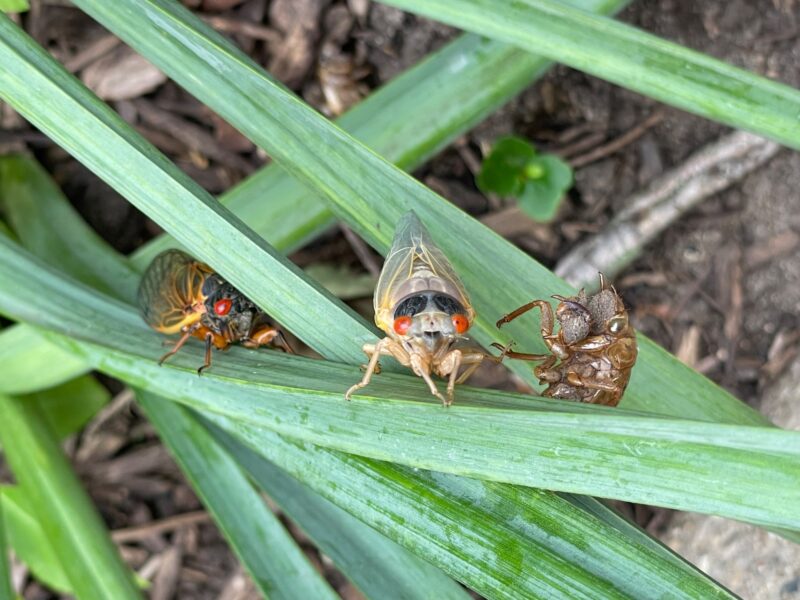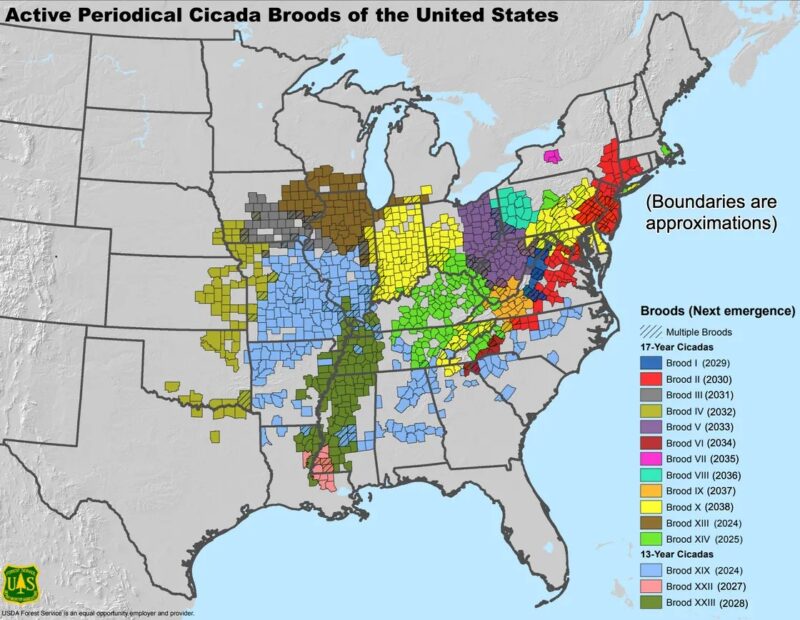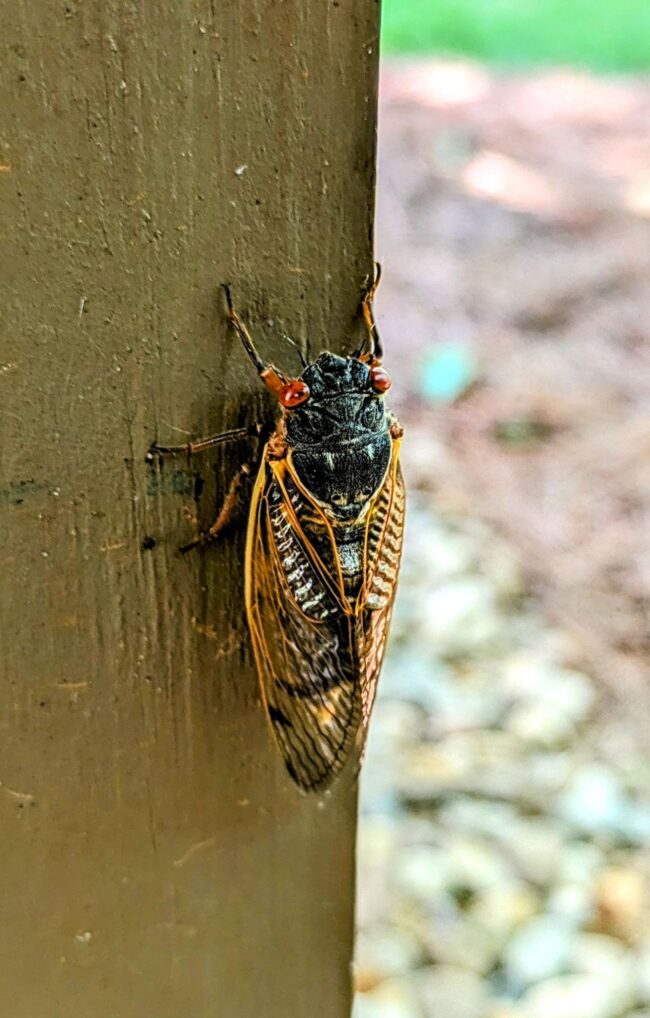This man is eating cicada gumbo at Cicadapalooza, a festival of cicadas at Lake Geneva, Wisconsin. Yum or yech? Watch the video above for more scenes from the festival.
- Trillions of cicadas are now emerging across parts of the U.S.
- Cicadas follow 13- and 17-year cycles. This rare double cicada mega-brood emergence happens only once every 221 years.
- Cicadas are harmless to humans. Though sometimes confused with locusts, their potential harm to plants isn’t too serious. No need to break out the insecticides. On the other hand, cicadas can be loud. Their buzzing reaches up to 106.7 decibels.
The cicadas are here
Cicadas don’t emerge in the spring until the soil 8 inches (20 cm) from the surface reaches 64 degrees Fahrenheit (17 C). So now it’s time. The cicadas are here! So if you haven’t already seen a red-eyed, chirping, winged insect near you, then you don’t live in an area prone to them. Even within states that have cicadas, the swarms can be hit or miss.
This year’s cicada emergence has seen a lot of press, because two broods are emerging, both a 13-year and 17-year brood. However, the two broods don’t all come out at once or even in the same region. The only overlap is in a small region of Illinois.

The what, when and where of 2024’s cicadas
Cicadas – members of the order Hemiptera along with stink bugs, bedbugs and aphids – spend as long as 17 years underground before emerging as adults. This year, the bugs will dig their way to freedom across 1.5 million acres throughout the Eastern U.S., an area roughly the same size as the state of Delaware.
Researchers from the University of Connecticut (UConn) said:
If we accept an estimate of a million cicadas per acre and if the total combined area of a periodical cicada emergence is roughly the size of Delaware, then more than a trillion cicadas will be involved. For 2024, since cicadas will emerge from Maryland to Oklahoma, Illinois to Alabama, clearly, trillions of adult cicadas will be present, but not all in the same place at the same time.

Rare double cicada mega-brood emergence
Cicada Safari says 2024 is a banner year for cicadas, as two of the biggest broods emerge in bordering areas of the Midwest:
The 17-year Brood XIII will emerge in northern Illinois, while the 13-year Brood XIX will emerge in parts of the southeastern United States. It is not common to have a dual emergence between Broods XIII and XIX. They occur once every 221 years, and the last time these two broods emerged together was in 1803.
In 1803, Thomas Jefferson was president of the United States, and Lewis and Clark started their exploration of the Louisiana Purchase.
The areas where Brood XIII and Brood XIX occur mostly don’t overlap, according to the cicada experts at UConn. However, there could be small areas where both broods are active:
The greatest likelihood of contact between these broods is around Springfield, Illinois. … While there may be scattered woods in which both broods are present, there will be no broad overlap, and it will be impossible, in 2024, to identify any areas of overlap, large or small.
Cicada Safari offers tips on where to see cicadas, all kinds of cicada facts and figures, and has a cicada tracking app so amateur entomologists can get in on the cicada action.

Cicadas are subterranean math wizards
A common misconception is cicadas are a kind of locust or grasshopper. They aren’t. With their large red eyes and long body, the insects do resemble locusts but instead are “true insects” of the order Hemiptera.
Cicadas appear on every continent but Antarctica. There are 190 varieties of the insects in North America, and about 3,400 varieties recorded worldwide so far. Some kinds of cicadas appear every year, while the periodic cicadas appear on 13- and 17-year cycles.
As fryrsquared explains via TikTok, 13 and 17 are prime numbers that can’t be factored. This means Brood XIII with its 17-year cycle and Brood XIX with its 13-year cycle can only emerge together every 221 years.
@fryrsquared The big news story of 2024 that literally no one is talking about ? #2024 #math #maths #circada ? original sound – fryrsquared
Don’t spray the cicadas!
Cicadas are loud but basically harmless to humans and the environment, so there’s no need to break out the insecticide. When they emerge, the only thing they’re interested in is mating and laying eggs, says UConn:
Cicadas do not possess special defensive mechanisms; they do not sting or bite. The ovipositor is used only for laying eggs and the mouthparts are used only for feeding on twigs; thus, periodical cicadas can hurt you only if they mistake you for a tree branch!
Cicadas will fly off when they feel threatened, and the males will make their iconic buzz. That buzz – produced when males flex drum-like organs called tymbals – is loud, reaching up to 106.7 decibels, about the same as a chainsaw.
The male cicadas sing during the day to attract females. Dog-day (annual) cicadas tend to sing more in late afternoon and evening. Each cicada species has its own distinctive sound to avoid attracting the wrong cicada. Typically, periodical cicada emergences consist of three species that can be distinguished by the male songs as well as by slight differences in their appearance. The nymphs of these cicadas feed on the roots of trees and shrubs.

Insects are disappearing
Leaving all insects alone is probably a good idea these days. According to a peer-reviewed study by German biologists published in 2017, the biomass of winged insects has declined by 76% since 1990. The researchers warn this decline in insect populations could have devastating effects across the entire global environment:
For example, 80% of wild plants are estimated to depend on insects for pollination, while 60% of birds rely on insects as a food source. The ecosystem services provided by wild insects have been estimated at $57 billion annually in the U.S. Clearly, preserving insect abundance and diversity should constitute a prime conservation priority.
If you take any photos of the cicadas, send them to us!
Bottom line: The cicadas are here! Have you seen – and heard them – in your neighborhood? Cicadas may be plentiful and loud, but they’re basically harmless.
Read more: Insects have declined worldwide since 1925
The post Cicadas are emerging across parts of the U.S. first appeared on EarthSky.
from EarthSky https://ift.tt/VvAdkWb
This man is eating cicada gumbo at Cicadapalooza, a festival of cicadas at Lake Geneva, Wisconsin. Yum or yech? Watch the video above for more scenes from the festival.
- Trillions of cicadas are now emerging across parts of the U.S.
- Cicadas follow 13- and 17-year cycles. This rare double cicada mega-brood emergence happens only once every 221 years.
- Cicadas are harmless to humans. Though sometimes confused with locusts, their potential harm to plants isn’t too serious. No need to break out the insecticides. On the other hand, cicadas can be loud. Their buzzing reaches up to 106.7 decibels.
The cicadas are here
Cicadas don’t emerge in the spring until the soil 8 inches (20 cm) from the surface reaches 64 degrees Fahrenheit (17 C). So now it’s time. The cicadas are here! So if you haven’t already seen a red-eyed, chirping, winged insect near you, then you don’t live in an area prone to them. Even within states that have cicadas, the swarms can be hit or miss.
This year’s cicada emergence has seen a lot of press, because two broods are emerging, both a 13-year and 17-year brood. However, the two broods don’t all come out at once or even in the same region. The only overlap is in a small region of Illinois.

The what, when and where of 2024’s cicadas
Cicadas – members of the order Hemiptera along with stink bugs, bedbugs and aphids – spend as long as 17 years underground before emerging as adults. This year, the bugs will dig their way to freedom across 1.5 million acres throughout the Eastern U.S., an area roughly the same size as the state of Delaware.
Researchers from the University of Connecticut (UConn) said:
If we accept an estimate of a million cicadas per acre and if the total combined area of a periodical cicada emergence is roughly the size of Delaware, then more than a trillion cicadas will be involved. For 2024, since cicadas will emerge from Maryland to Oklahoma, Illinois to Alabama, clearly, trillions of adult cicadas will be present, but not all in the same place at the same time.

Rare double cicada mega-brood emergence
Cicada Safari says 2024 is a banner year for cicadas, as two of the biggest broods emerge in bordering areas of the Midwest:
The 17-year Brood XIII will emerge in northern Illinois, while the 13-year Brood XIX will emerge in parts of the southeastern United States. It is not common to have a dual emergence between Broods XIII and XIX. They occur once every 221 years, and the last time these two broods emerged together was in 1803.
In 1803, Thomas Jefferson was president of the United States, and Lewis and Clark started their exploration of the Louisiana Purchase.
The areas where Brood XIII and Brood XIX occur mostly don’t overlap, according to the cicada experts at UConn. However, there could be small areas where both broods are active:
The greatest likelihood of contact between these broods is around Springfield, Illinois. … While there may be scattered woods in which both broods are present, there will be no broad overlap, and it will be impossible, in 2024, to identify any areas of overlap, large or small.
Cicada Safari offers tips on where to see cicadas, all kinds of cicada facts and figures, and has a cicada tracking app so amateur entomologists can get in on the cicada action.

Cicadas are subterranean math wizards
A common misconception is cicadas are a kind of locust or grasshopper. They aren’t. With their large red eyes and long body, the insects do resemble locusts but instead are “true insects” of the order Hemiptera.
Cicadas appear on every continent but Antarctica. There are 190 varieties of the insects in North America, and about 3,400 varieties recorded worldwide so far. Some kinds of cicadas appear every year, while the periodic cicadas appear on 13- and 17-year cycles.
As fryrsquared explains via TikTok, 13 and 17 are prime numbers that can’t be factored. This means Brood XIII with its 17-year cycle and Brood XIX with its 13-year cycle can only emerge together every 221 years.
@fryrsquared The big news story of 2024 that literally no one is talking about ? #2024 #math #maths #circada ? original sound – fryrsquared
Don’t spray the cicadas!
Cicadas are loud but basically harmless to humans and the environment, so there’s no need to break out the insecticide. When they emerge, the only thing they’re interested in is mating and laying eggs, says UConn:
Cicadas do not possess special defensive mechanisms; they do not sting or bite. The ovipositor is used only for laying eggs and the mouthparts are used only for feeding on twigs; thus, periodical cicadas can hurt you only if they mistake you for a tree branch!
Cicadas will fly off when they feel threatened, and the males will make their iconic buzz. That buzz – produced when males flex drum-like organs called tymbals – is loud, reaching up to 106.7 decibels, about the same as a chainsaw.
The male cicadas sing during the day to attract females. Dog-day (annual) cicadas tend to sing more in late afternoon and evening. Each cicada species has its own distinctive sound to avoid attracting the wrong cicada. Typically, periodical cicada emergences consist of three species that can be distinguished by the male songs as well as by slight differences in their appearance. The nymphs of these cicadas feed on the roots of trees and shrubs.

Insects are disappearing
Leaving all insects alone is probably a good idea these days. According to a peer-reviewed study by German biologists published in 2017, the biomass of winged insects has declined by 76% since 1990. The researchers warn this decline in insect populations could have devastating effects across the entire global environment:
For example, 80% of wild plants are estimated to depend on insects for pollination, while 60% of birds rely on insects as a food source. The ecosystem services provided by wild insects have been estimated at $57 billion annually in the U.S. Clearly, preserving insect abundance and diversity should constitute a prime conservation priority.
If you take any photos of the cicadas, send them to us!
Bottom line: The cicadas are here! Have you seen – and heard them – in your neighborhood? Cicadas may be plentiful and loud, but they’re basically harmless.
Read more: Insects have declined worldwide since 1925
The post Cicadas are emerging across parts of the U.S. first appeared on EarthSky.
from EarthSky https://ift.tt/VvAdkWb

Aucun commentaire:
Enregistrer un commentaire